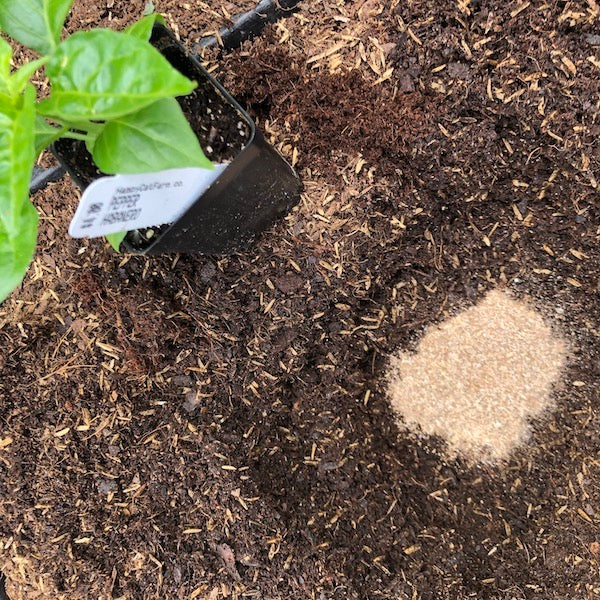Tomato Tips Everyone Can Use
Share
It’s July and your tomato plants are happily in the ground—and maybe have been for three or more weeks. However, like a watched pot that never boils, your harvest isn’t going to come any sooner just by standing by. Yes, weather plays a big part. But there’s plenty you can actively do other than alternating your stare between your wristwatch and your tomato crop.

We’ve pulled together a few tips that gardeners of all skill levels will find useful if not new. And if you have a tip of your own, we’d love to hear about it.
About That Weather
You might be wondering why your tomatoes have not yet grown all that much. They seem to be proceeding in fits and starts. It’s likely the temperature. Tomatoes are undeniably hot weather-loving plants. Folks in the Mid-Atlantic and Northeast have had some warm days, that’s true. It’s the consistency that is lacking. The month of May was cool nearly to the finish, and since then evening temperatures—and some daytime temps—have been erratic. It was just 47F the other morning! Now that it’s July, reliably warm day and night temperatures should be with us. And with that, you’ll see your tomatoes really take off.

Tie Those Tomatoes Up
While your plants are still small, now is the time to help them stay off the ground. You could do that in a number of ways. Some folks like tomato cages. Some use one sturdy stake onto which you can tie off the growing branches. Some use a trellis-type system with hanging strings for the same purpose.

Some use a technique called the Florida weave or some spin on that concept. For this weave, a row of tomatoes is sandwiched between two lengths of string attached to stakes at the end of each row (and maybe a stake or two in the row as well). As the tomato plant grows up, additional strings are attached to the stakes, keeping the plants from toppling over. The “weave” comes in when the string on the left of one plant weaves itself to the right of the next plant, and the opposite for the second string. Whereas the single plant-single stake requires tying branches to the stakes as they grow, this weaving just needs to have branches directed through the two strings for support. No (or very little) additional tying is required.
Pinch the Tomato Suckers
A tomato plant ideally has one main steam, the leader. Leaves will grow off of this main branch on either side. Another fruit-producing shoots will grow out of the axils—the point where the branch and the leaves join. These auxiliary stems are often referred to as suckers. Remove these suckers!

But why, if they produce fruit? We have several reasons why they should be removed. First, these side shoots use up a lot of energy that would otherwise be used to support the fruiting of the main stem. This redirected energy could go back into the main stem and help those fruits grow and become bigger. That’s a great thing.
Second, the more side shoots growing off the plant, the more gangly the plant becomes; i.e., it’s hard to keep the whole plant upright on whatever staking system you are using. And for some very vigorous indeterminate heirloom varieties, managing all those vines can become a nightmare.
And third—to be honest, the bottom foot of a tomato plant, leaves and all, eventually yellows and dies. Removing any suckers that emerge is one way to take away any material that will eventually die and possibly cause disease. Trust us, removing suckers is the way to go. It’s the method used in most modern production greenhouses that grow tomatoes for harvest.
Water Your Tomatoes Consistently
Watering your tomatoes evenly throughout the growing season will minimize the cracking that sometimes occurs. It also helps prevent blossom end rot by helping to pull nutrients up through the plant to where they are needed.
If you find it difficult to maintain an even moisture level, consider installing a drip irrigation system. This can provide a determined amount of water at the schedule of your choosing, and can direct it to the plants’ roots, unlike a hose and nozzle.
Add Frass

Insect Frass is a terrific product for all sorts of plants—veggies, houseplant, native plants, you name it. It’s super good for vegetables and especially for tomatoes. This 3-2-2 formulation is organic and vegan and is suitable for all stages of plant growth. For your tomatoes, sprinkle, or “side dress,” around your plants, scratch it into the top inch of soil and water it in. Do this once every four weeks and your tomato plants will reward your efforts. Our Organic Mechanics Insect Frass is available in 2-lb. and 5-lb. bags. Find your supply HERE.
Following our quick tips will bring you a tasty harvest. And it’s a lot better—and more engaging—than just standing around waiting for a tomato to ripen.



